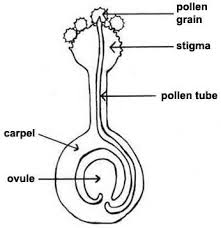Hand Pollinating - it's the bee's knees

Today I spent a considerable amount of time pretending to be a bee. Not in the halloween sense, mind you.

Rather, I was acting as a real bee; collecting pollen (male gametes from the anthers) from a flower on one plant and then placing it delicately on the pistil (the female part of the flower) of another plant in order to make a seed.


As a "bee", I am only placing a grain of pollen on the stigma. As a botanist and researcher, I am hoping the pollen grain will "sprout" a pollen tube, which will grow through the stigma and style, eventually successfully reaching a carpel and fusing with the egg (the female gamete) to create a zygote which will develop into a seed.

Some plants have monoecious flowers / "complete flowers" / "perfect flowers" meaning that there are male parts (stamen) and female parts (pistil) on the same flower. (Click here to read a blog about animal vs plant parentage and patterns of inheritance)
If these monoecious plants are self-compatible, then the pollen from the stamen can land on the pistil of the same flower and form a zygote which will develop in to a seed. This self compatibility is good and bad.
It is bad because it can lead to inbreeding which allows dangerous mutations to surface and hurt the seedlings and future generations ability to survive.
It is good because if the plant is all alone, it can still make seeds and produce more plants - some of which will hopefully avoid the dangerous mutations. This allows the plant to spread to new territory far away from other plants where light and water are plenty.
The plants I am crossing for my research are not self-compatible, so I do not have to be as careful when I make my rounds as a bee. They are wild tomato plants (Solanum habrochaites) - distant relatives of the large, red tomatoes we eat today (Solanum lycopersicum).

Most of the foods we eat are the fruits or seeds of plants, and there are parts of the flower you can still see in the fruit.
Check out this great comparison of a tomato fruit and tomato flower from BioGraphix!
The internet is abundant with neat pictures and good information about flowering plants. Click here to see one I enjoyed or, for a more thorough basic biology site, try here.
Here's a great set of lessons on the 'Kaleidoscope of Life', including flowering plants, put together by an Interdisciplinary group at Michigan State University.
For more about honey bees (and beekeeping) click here!